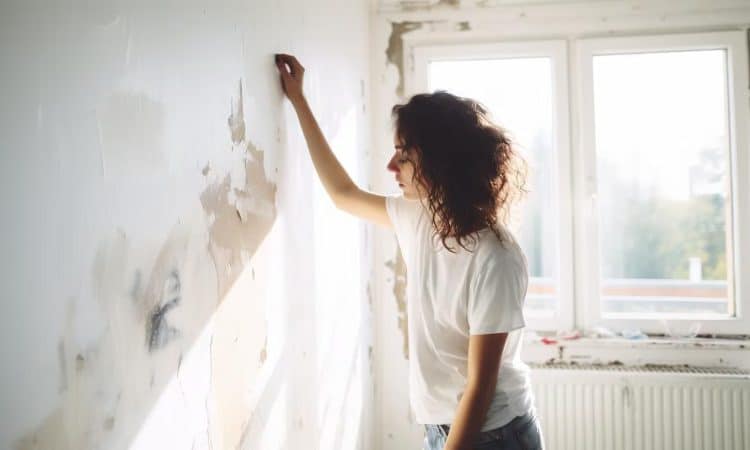
It is a common problem on painted surfaces, especially in poorly ventilated areas. Weather changes and recent rains have aggravated the situation, affecting both interiors and exteriors.
We all know how frustrating it can be when fungus starts to grow on painted surfaces in the home. It’s especially common in areas with high humidity and poor ventilation. We all know how it goes. The weather outside is frightful, and so are those black spots on your walls! They can appear in areas with less ventilation, like wall junctions with beams, recesses, or second-floor balcony ceilings. And with the recent temperature swings and high humidity, they’ve been popping up more than usual. But don’t fret! There are ways to keep your home’s interiors looking their best, even in the face of these challenges.
All this can directly affect exterior surfaces, even more so if they are recently painted, underline specialists in home maintenance.
“This effect also appears, and not coincidentally, in places where there is a lot of vegetation, such as trees and various plants. Faced with this fact, there is no other solution than to clean the fungi with a solution of hypochlorite (bleach) in water or with specific antifungal cleaning products,” Hugo Drago, technical advisor of Sui Color paint shops, told Infobae.
What attracts fungi
In exteriors, the rapid formation of fungi manifests itself as black spots on painted surfaces, especially in areas with humidity condensation caused by low temperatures and abundant vegetation.
“Indoors, causes include poor ventilation, the use of heaters without an outdoor outlet and the presence of cold walls with south/southeast orientation, where there are wide temperature jumps between indoors and outdoors. High humidity also favors the proliferation of fungi,” Drago added.
To prevent fungal growth on exterior surfaces, especially in areas with high humidity and nearby vegetation, it is critical to choose the right materials and practices. “Smog and pollution are unavoidable, but they can generate cracks and cavities where verdigris and tree seeds that germinate easily form,” said architect Gabriela Correa, a specialist in project design, management and execution of new construction and remodeling, and stressed the importance of constant maintenance.
Coatings with incorporated color and different textures, well applied, can offer good results. “As for maintenance, it is crucial to check the surface and opt for acrylic-based aqueous waterproofing or waterproofing paints for exteriors,” Correa expanded.
Recommended paints
For interiors, special latex paints are recommended for bathrooms and kitchens that contain effective antifungal additives and super washable latex.
“Also, latex paints with nanotechnology include silver particles with natural antifungal activity. For exteriors, waterproofing products with certain elasticity in their film are suggested, generally self-cleaning, which make it difficult for fungi to anchor,” Drago said.
Paints and coatings must have certain characteristics to be effective in preventing fungus.
Ventilation and humidity control are essential, especially indoors. Cross ventilation and the use of exhaust fans in kitchens and bathrooms are critical to reduce moisture.
“Often, clients have bathrooms with windows but still face moisture problems due to lack of adequate ventilation during the winter. The choice of colors and pigmentation also influences protection, as light colors reflect light better and help reduce surface moisture,” the specialist added.
Surface preparation
Preparing a surface before applying antifungal paint is essential. A firm and clean surface must be obtained. In case of fungi, it is necessary to wash it with a solution of hypochlorite and water (10% bleach, 90% water), avoiding mopping so as not to transfer the microorganisms.
“For exteriors, hydro-washes with antifungal additives can be used. Once dry, the appropriate paint or textured coating is applied, following the manufacturer’s instructions,” Drago said.
Climatic conditions, such as high humidity and temperature jumps, have a significant influence on the proliferation of fungi on painted surfaces, especially on cold walls. Properly preparing and treating surfaces before painting is crucial to ensure effective protection against fungi.According to Correa, the first step on new plaster is to sand the surface to remove debris and improve smoothing, followed by a good primer base. “Both in cases of repainting and in new plaster, it is essential to iron the surface with enduro and plaster to level the wall, sand and touch up with enduro as many times as necessary, and then apply a fixative that serves as an adhesion bridge before the final painting,” he explained.
It is also important to respect the drying times at each stage to avoid the appearance of fungus.
Correa advised checking surfaces and using waterproofing. “In interiors, ventilation is key and the choice of paints should consider light. Preparing the surfaces well is fundamental.
Values
The price range of antifungal paints varies significantly. For domestic paints, prices range from $16,000 per liter to $58,000 for four liters.
For imported paints, prices range from $25,000 per liter to $80,000 for four liters.
“These paints guarantee the maintenance in perfect condition of walls, both interior and exterior, without the appearance of fungus for a period of 5 to 6 years, as long as the surfaces are free of fungus at the time of application,” Drago said.
The total cost of exterior wall and surface repairs prior to painting ranges from USD 100 to USD 300 per square meter.

